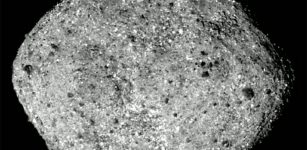New Horizons Spacecraft Reveals: Mysterious Kerberos – Last Of Pluto’s Moons
MessageToEagle.com – An image of Pluto’s tiny and mysterious moon Kerberos was beamed back this week by NASA’s New Horizons spacecraft.
New Horizons spacecraft made its close flyby of Pluto in July this year and thus, the probe has completed the “family portrait” of Pluto’s moons, the space agency informed Thursday.
Kerberos appears to be smaller than scientists expected and has a highly-reflective surface, counter to predictions prior to the Pluto flyby in July.

Kerberos appears to have a double-lobed shape, approximately 7.4 miles (12 kilometers) across in its long dimension and 2.8 miles (4.5 kilometers) in its shortest dimension.
“Once again, the Pluto system has surprised us,” said New Horizons Project Scientist Hal Weaver, of the Johns Hopkins University Applied Physics Laboratory in Laurel, Maryland.
The new data, downlinked from the New Horizons spacecraft on Oct. 20, show that Kerberos appears to have a double-lobed shape, with the larger lobe approximately 5 miles (8 kilometers) across and the smaller lobe approximately 3 miles (5 kilometers) across.

Science team members speculate from its unusual shape that Kerberos could have been formed by the merger of two smaller objects.
The reflectivity of Kerberos’ surface is similar to that of Pluto’s other small moons (approximately 50 percent) and strongly suggests Kerberos, like the others, is coated with relatively clean water ice.
Before the New Horizons encounter with Pluto, researchers had used Hubble Space Telescope images to “weigh” Kerberos by measuring its gravitational influence on its neighboring moons. That influence was surprisingly strong, considering how faint Kerberos was.

They theorized that Kerberos was relatively large and massive, appearing faint only because its surface was covered in dark material. But the small, bright-surfaced Kerberos–now revealed in these new images–shows that the idea was incorrect, for reasons that are not yet understood.
“Our predictions were nearly spot-on for the other small moons, but not for Kerberos,” said New Horizons co-investigator Mark Showalter, of the SETI Institute in Mountain View, California.
The new results are expected to lead to a better understanding of Pluto’s fascinating satellite system.
MessageToEagle.com
source:










